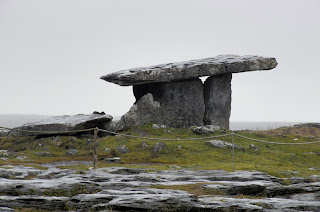“It is a country where
there is not enough water to drown a man, nor wood enough to hang one, nor
earth enough to bury him,” said Lieutenant-General Edmund Ludlow of
England. In the three-hundred and sixty
years since the lieutenant-general visited Ireland’s Burren, it is safe to say
that this geographical wonder has changed little. Indeed, while hanging and drowning men was
not in the forefront of our minds during the College’s visit to the Burren, we
would have been hard pressed to prove Ludlow wrong.
Nestled in County Clare,
the Burren attracts thousands of tourists yearly, containing famous villages
such as Lisdoonvarna, Ballyvaughan, and Kinvarna, remarkable landmarks such as
the Cliffs of Moher and Blackhead and, of course, rocks. Lots and lots of rocks. More rocks than you will see in one place for
the rest of your life, guaranteed.
Because, equally remarkably, there is no place else in the world like
the Burren. It is unique to Ireland and
it is one of the many things that make Ireland unique to the world.
Limestone encrusts the
ridges of the Burren like cracking plates of ice on the swells of an ancient
sea. Cliffs jut unexpectedly from the
landscape, the earth forming and dissolving around the narrow roadways that
seem so out of place on this alien land.
Boulders lay like the broken remains of a giant’s football, tossed aside
by the glaciers and left to shade solitary patches of earth—the only shade most
of the Burren knows. Marbled with
crevices called “grikes” and massive caves, this place is unexpectedly
treacherous. And yet we were repeatedly
told that the cows are always fatter when raised in the Burren. Personally, I found it hard to believe that
any form of livestock could be long for that world until I saw a dairy cow
wandering up a slippery hillside, with a cluster of sheep and one pudgy pony in
tow.
Because of its geology,
the Burren harbors innumerable species of native flora and fauna that either
cannot be found anywhere else in the world or that should never have been found
here (excluding the dairy cow, who continues to baffle me). Artic flowers, rare insects and wily foxes coexist
in a land that looks to have never known life.
In fact, because of the sunlight the dark stones absorb and the rain
that continuously soaks its earth, the Burren has a moderate climate that
encourages lush vegetation. I bought a
bottle of water from one of the small villages that speckle the area and saw
that Ballygowan mineral water claims 750 years of limestone filtered
purity. Yes, it was delicious. No, it did not taste like dirt.
The dairy cow
I saw, as it turns out, was one of the many that belong to farmers whose
families have lived in this area for centuries.
Ancient lore, passed down by legends, thrive with the same rich diversity
here as the plants and animals who also call it home. At the Burren Center in Kilfenora,
County Clare Ireland, visitors can learn not only of this vibrant human history,
but also the fantastic geologic evolution that molded the lore. I highly recommend this museum, which you can
have a look at yourself at http://www.theburrencentre.ie/
.
Knowing that people have lived here since ancient times
and that there isn’t enough soil to bury a man, I should have anticipated that professor,
Dave Ansett, would propose the question of “what do you think they did with
grandma?” during our drive. This brought
us pause and it wasn’t until we passed a bizarre, square landmark that I
understood the answer. Obviously built
from the stones that make this place unique, the ‘portal tomb’ thrust its
ancient head high above the surrounding earth, reminding the world of forgotten
civilizations. Since their dead could
not be buried, the Burren’s ancients constructed these formations to mark the
resting places of their families. While
the exact use of these structures is debated (Were they used for rituals? Did they serve a purpose other than as a
marker?), the history and dedication that they now represent is indisputable.
From the plated crests of the Burren’s sun warmed ridges
to the shadowy crevices that have never known light, this place adds a serene
quality to Ireland’s beauty. I look
forward to returning in May, when the wildflowers will be in full bloom (though
I will still be too early for the orchids, I’m told) and the grasses so green
that they tint the air. I look forward
to visiting at least one portal tomb, buying around two bottles of Ballygowan
water…
…And re-finding exactly three windblown trees.
~K




















